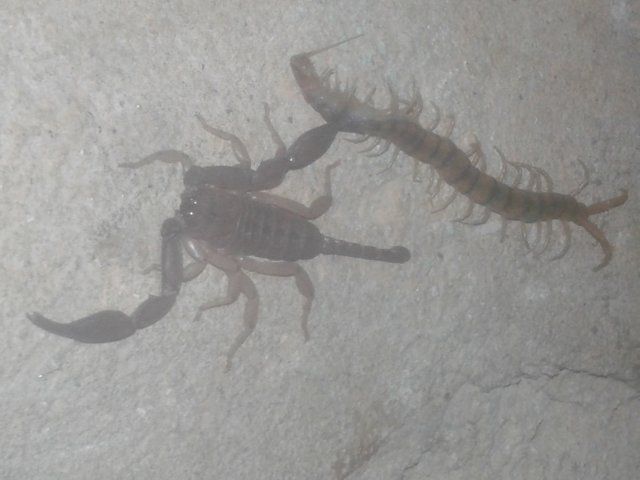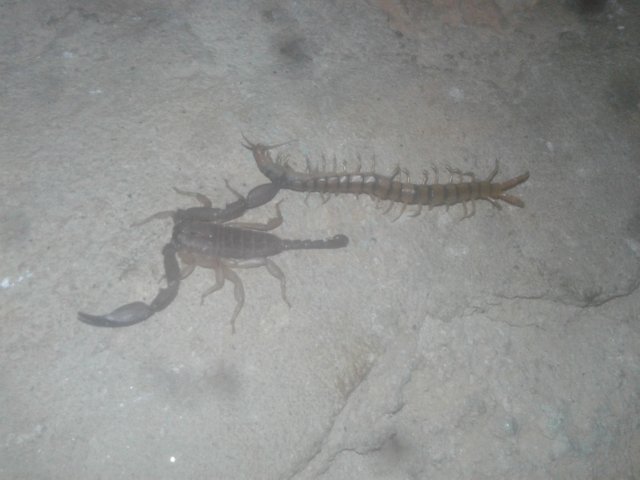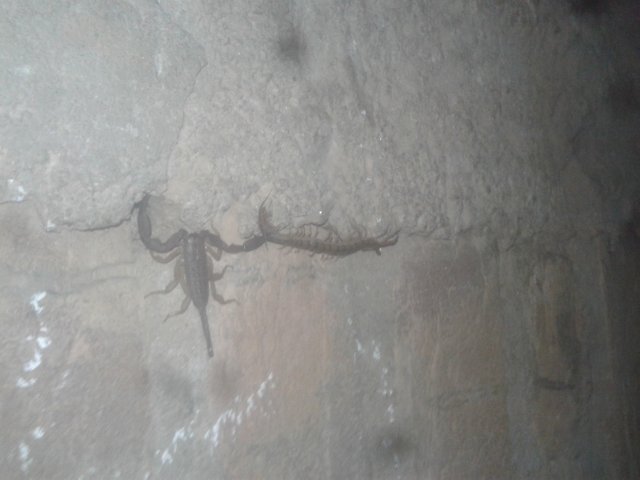Scorpion and chilopoda fight night t n wall
Last night my best photography in best photography in my life. In my small mobile photography not HD
SCORPION
Scorpions are predatory arachnids of the order Scorpiones. They have eight legs and are easily recognized by the pair of grasping pedipalps and the narrow, segmented tail, often carried in a characteristic forward curve over the back, ending with a venomous stinger. Scorpions range in size from 9 mm / 0.3 in
The evolutionary history of scorpions goes back to the Silurian period 430 million years ago. They have adapted to a wide range of environmental conditions, and they can now be found on all continents except Antarctica. Scorpions number about 1,750 described species,[3] with 13 extant (living) families recognised to date. The taxonomy has undergone changes and is likely to change further, as genetic studies are bringing forth new information. All scorpions have a venomous sting, but the vast majority of the species do not represent a serious threat to humans, and in most cases, healthy adults do not need any medical treatment after being stung.[4] Only about 25 species are known to have venom capable of killing a human.[5]:1 In some parts of the world with highly venomous species, human fatalities regularly occur, primarily in areas with limited access to medical treatment.[4]
CHILOPODA
Characteristics Centipedes are easily recognisable but despite their name few actually posses 100 legs or more. They may be confused with millipedes but can be distinguished by the following characteristics: 1 pair of legs per body segment 1 pair of poison claws/fangs underneath the head Antennae present Simple eyes The last pair of legs in many centipedes are often strong and brightly coloured and although look quite dangerous and venomous are only used to grasp prey or wave in a defensive display. The bite of centipedes may be painful to humans but is not deadly and usually only results in localised swelling and irritation. Scolopendrid centipedes like the one pictured above are robust species ranging from 5-10 centimetres in length. Most have between 21 and 23 pairs of legs with the last pair usually longer and thicker and used for grasping prey. These grasping legs are often a bright red colour and are sometimes thought to be 'poison jaws' but are totally harmless. Scolopendrid species are more common in the drier areas of the country and can often be found under rocks and logs or under the bark of trees. Life Cycle Male centipedes usually spin a small web onto which they deposit a sperm packet for the female to pick up. In some species there may be a short courtship dance or tapping of antennae before the female is encouraged to take the sperm packet into her genital opening. Eggs may be laid in groups or singularly under a rock or log, in the soil or under bark and may or may not be guarded by the female depending on the species. Some species on hatching look exactly like their parents and have the full complement of legs and body segments. Other species have less legs and body segments than their parents and will gain more with successive moults. Centipedes will moult several times before reaching sexual maturity. Feeding Centipedes are predatory and will kill and consume a variety of other invertebrates such as spiders, molluscs, many insects, slaters and other centipedes. Some have been observed feeding on small vertebrates such as frogs, mice and small geckoes. Prey is usually immobilised by venom injected through the fangs and then torn into pieces by the mandibles and the soft parts are eaten. Geophilida (earth centipedes) Habitat Centipedes are found in a variety of habitats in Australia depending on the species, ranging from moist rainforests to the drier regions of Australia. Centipedes can usually be found living under rocks, logs or the bark of trees or in soil or leaf litter. Many species are common around human dwellings and are often seen in compost heaps or other garden refuse, while some may even venture into houses. Earth centipedes are very long and slender and usually found in moist habitats such as under rocks and logs or in leaf litter. Most species are blind and can be distinguished from other centipedes as they have more than 31 pairs of legs. They have rectangular shaped heads and relatively short legs which enable them to move with ease through the leaf litter and soil of their environment.
So emotional moment chilopoda is no chance to run. Chilopoda is no more. The scorpion is very power full n chilopoda. Scorpion go n has place 